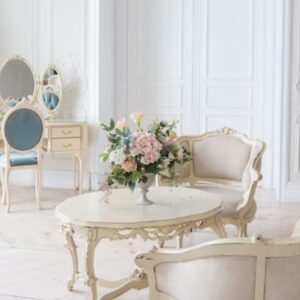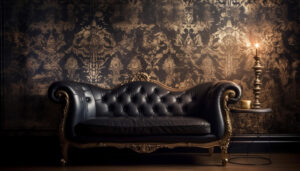
Introduction:
Hey there, young explorer! Are you ready to embark on a journey through time and discover the fascinating world of classic-style furniture?
Get ready to step into the enchanting realm of the past, where furniture pieces were crafted with great care and artistic beauty.
In this article, we’ll learn all about classic style furniture and how it continues to bring elegance and charm to homes even today. So, grab your magnifying glass and let’s dive into the wonderful world of classic furniture!
The Time Machine

Imagine we have a magical time machine that can transport us back to the 1500s, a time known as the Renaissance period. This was a time when artists and craftsmen created magnificent furniture pieces using their skills and imagination. The ornate designs, rich materials, and attention to detail they used, gave birth to what we now admire as classic-style furniture.
The Elements of Classic Style Furniture
Ornate Designs:
Classic-style furniture often features intricate designs and detailed carvings. Skilled craftsmen would spend countless hours shaping wood into delicate patterns and motifs. These designs can be inspired by nature, mythology, or even historical events.
Rich Materials:
In the 1500s, furniture makers used luxurious materials like mahogany, oak, and walnut to craft timeless masterpieces. These materials were not only durable but also had a rich, warm appearance. The fine woodwork often served as a statement of wealth and elegance.
Elegant Upholstery:
Classic type furniture is known for its elegant upholstery, which refers to the fabric or leather covering on chairs, sofas, and other pieces. It could be a regal velvet or refined silk, often in rich colors like deep red, gold, or royal blue, contributed to the overall grandeur of the furniture. The combination of high-quality fabric and expert craftsmanship created a sense of luxury and sophistication.
The Classic Style Furniture Collection
Royal Thrones:

Among the most iconic pieces of classic furniture is the royal throne. It was a majestic chair reserved for kings and queens. Thrones were adorned with elaborate carvings, plush cushions and rich upholstery, showcasing the power and grandeur of the monarchs. These royal pieces were designed not just for comfort, but to showcase the power and status of their rulers.
Grand Four-Poster Beds:

Classic-style bedrooms featured grand four-poster beds that were fit for royalty. These beds had tall, ornate posts at each corner and were draped with luxurious fabrics, these beds provided both comfort and grandeur, creating a cozy yet regal sleeping space. They were often the centerpiece of the room, designed to arouse a sense of royalty and elegance.
Charming Tables and Chairs:

In the 1500s, tables and chairs were not just functional but also pieces of art. Tables were often large and sturdy, with intricate carvings on the legs and tabletops. Chairs had curved backs and comfortable cushions, making them perfect for long conversations and feasts. These items perfectly captured the classic style’s blend of elegance and functionality.
The Legacy of Classic Style Furniture
Timeless Appeal:
Classic style furniture has a timeless appeal that has endured for centuries. It’s intricate designs and rich materials continue to captivate people’s hearts, making it a popular choice for those seeking elegance and sophistication in their homes. Whether it’s the luxurious woodwork or ornate detailing, these pieces give any space a lasting sense of beauty
Heritage and Tradition:
Owning a piece of classic-style furniture is like owning a slice of history. These furniture pieces carry the heritage and traditions of the past. They remind us of the craftsmanship and artistry of the people who came before us. They connect us to a rich legacy of skilled artisans and timeless design.
Modern Interpretations:
While classic style furniture originated in the 1500s, it has continually evolved. Today, you can find modern interpretations of classic designs that blend the elegance of the past with the functionality and comfort of the present. These pieces often feature simplified designs and lighter materials, making them ideal for modern living spaces.
How to Take Care of Classic Style Furniture
Taking proper care of classic-style furniture ensures that it retains its beauty and functionality for generations. From gentle cleaning to protection from environmental factors, these tips will help you preserve your furniture’s elegance and craftsmanship.
Gentle Cleaning:
To prolong the life of classic-style furniture, regular cleaning is essential. Use a soft cloth or a feather duster to gently remove dust and dirt. Avoid using harsh chemicals or abrasive cleaners, as they can damage delicate finishes and diminish the beauty of the furniture..
Protection from Sunlight:
Direct sunlight can cause fading and damage the upholstery and wood of classic furniture. It’s advisable to place these pieces away from direct sunlight or use curtains and blinds to protect them from excessive sunlight exposure.
Proper Maintenance:
If you notice any loose joints or scratches on your classical style furniture, it’s crucial to address them promptly. Consult a professional furniture restorer who can repair and restore the piece to its former glory. Regular maintenance will ensure that your furniture remains in excellent condition for years to come.
Exploring Classic Furniture Styles
Baroque Style:

The Baroque period, which followed the Renaissance, classic furniture took on a more extravagant and dramatic style. Elaborate carvings, intricate details, and curvaceous forms characterized Baroque furniture. It reflected the opulence and grandeur of the time. These statement pieces aimed to impress and display wealth and power.
Rococo Style:

The Rococo period introduced a more playful and lighthearted approach to classic furniture. Curved lines, delicate ornamentation, and whimsical motifs were prominent features of Rococo-style furniture. It radiated elegance and charm, maintaining a sense of gracefulness, and designers often used it to create light, airy spaces.
Neoclassical Style:

In the late 18th century, the Neoclassical style emerged as a reaction against the excessive ornamentation of earlier periods. Influenced by ancient Greek and Roman designs, Neoclassical furniture emphasized clean lines, symmetry, and simplicity. It exuded a sense of sophistication and timeless beauty to interiors.
How to Add Classic Style to Your Home
Make a Statement with Statement Pieces
You can bring classic-style furniture to your home by introducing statement pieces that reflect elegance and craftsmanship. A beautifully carved console table in the entryway, an ornate mirror in the living room, or an elegant traditional dining table can instantly transform the ambience and add a touch of timeless elegance.
Blend Classic and Modern Styles Seamlessly
Don’t hesitate to mix classic furniture with modern elements. Combining a sleek, contemporary sofa with a vintage-inspired coffee table or classic dining chairs around a modern dining table can create a unique and eclectic look that showcases your style. This contrast can make your decor feel both curated and comfortable—old-world charm with modern flair.
Creating Cozy, Elegant Spaces:
Classic furniture is perfect for designing cozy and inviting spaces. Pair a comfortable armchair beside a vintage floor lamp and a soft throw to create a cozy reading nook. Add plush cushions, use a vintage rug and pair it with a classical nightstand to your bedroom to create a retreat filled with elegance and comfort.
Conclusion:

Congratulations, young explorer! You’ve delved deeper into the enchanting world of classic-style furniture. From caring for these timeless pieces to exploring different furniture styles and incorporating them into your home, you’ve gained a wealth of knowledge. Remember, this style of furniture is not only about aesthetics but also about preserving the heritage and craftsmanship of the past. So, go forth and embrace the beauty of classic-style furniture in your unique way!
